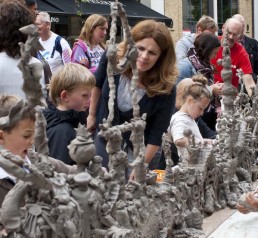Thames foreshore fragments and visual references
At Clayground we like to think we are encouraging people to make future archaeology by getting involved in clay today. We work with archaeologists to delve into London’s collections to illuminate the capital’s amazing history and inspire contemporary makers and ceramic appreciators. Many ceramic items can be found in the collections of the Museum of London at London Wall and at Docklands and local museums across the capital; some are in London’s archaeological archive and some are just lying around on the Thames foreshore.
With leading Thames archaeologist, Mike Webber, we conduct walks to gather some of these traces of London history. We will be conducting further walks next year at some point. Please let us know if you would like your name to be added to the waiting list.
We have found some treasures. Each fragment, its clay, the use and type of glaze, opens a window onto the social, technological and trading history of London. We see traces in clay of human fingers, some small enough to be those of a child, often employed for long hours in London’s potteries. In another, the imprint of a potter’s fingernail can be made out. We have found clay pipes aplenty; fragments from Roman domestic pots (no glaze/ greyish clay); medieval pottery with sparse green glaze on the outside; no less than two tile pieces from Tudor heating stoves (lovely green glaze and terracotta clay); the finial from a Tudor money box (green too); fragments of decoration from Bellarmine ware (brownish salt glaze called “orange peel”) and bits of creamy white Victorian dairy crocks. The money box probably once containing the takings from theatres on the south bank ferried across the river to be banked in the City. The clay pipes were doubtless dropped by men waiting on the piers for cargo to arrive or enjoying a well-earned beer at one of the many riverside taverns. We find evidence of London life in other materials too: bones, metal, wood, 17th century shoe leather and abalone shell fragments, waste from a button-making factory.
Here are visual references prepared by Mike to help you identify any sherds you may come across. (sherds = pottery; shards = glass fragments).
Clayground Collective
-
Pandemic clay action!
18th Aug 21
-
The Volcano and the Microbes: interaction between geology and biology
4th Jun 21
-
Perseverance: a new NASA rover continues to follow Martian clay
2nd Aug 20
-
Research into clay provides clues as to how much water there was on Mars
18th Sep 19
-
22 Hands: British Ceramics Biennial Commission
12th Aug 19
-
Clayground Summer Events
24th Jun 19
-
Colourful Clays on Mars
20th Feb 19
Thames foreshore fragments and visual references
4th Dec 12
How is clay formed? Is it inorganic or organic?
10th Sep 12
CLAY FROM AROUND THE WORLD
3rd Aug 11
Clay Cargo 2014 Collection: the Thames Foreshore
15th Dec 14
Clues to life on Mars likely to be found in clays, Javier Cuadros
5th Aug 16
Clay Cargo 2013-2015
15th Jun 15
Sessions on the Clay Cargo boat, hosted by Fordham Gallery
9th Mar 15
Civic Spaces, Exhibitions
Museums and Galleries, Regeneration
Maker spaces, Rural Sites
Archaeology
Youth and Adult Community Groups, Professionals
Art Groups, Families, Students
Collaborations, Archaeology Sheets
Commissions, Thinking Hands? Research
Knowledge Exchange












